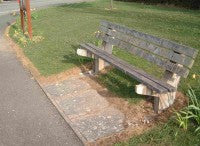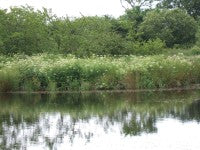Pesticide Roundup
 Some active ingredients may not be approved at all for sale or use in the UK, under the approvals process administered by the Chemicals Regulation Directorate, once the replacement regulations for 91/414EU come into effect. The new regulation changes emphasis to hazard-based rather than risk-based assessments.
Some active ingredients may not be approved at all for sale or use in the UK, under the approvals process administered by the Chemicals Regulation Directorate, once the replacement regulations for 91/414EU come into effect. The new regulation changes emphasis to hazard-based rather than risk-based assessments.
Much has already been written about the implications of this, and there is little doubt it will result in the demise of another raft of pesticides; suffice to say that glyphosate is not one of them, being already approved under Annex 1 and not under threat from any of the hazard-based criteria in the new regulation.
Two pieces of legislation which do impact on glyphosate use, are the EU Directive: Thematic Strategy for Sustainable use of pesticides and the Water Framework Directive (2000/06/EC), (WFD). Implementation to achieve the strategic outcomes required under both these EU Directives will be via the 'UK Pesticides Strategy' through five targeted Action Plans administered by Defra.
The Environment Action Plan covers water and biodiversity, and the Human Health Action Plan covers protection of humans. The most important one is the Amenity Action plan, because this encompasses all aspects pertaining to the amenity industry.
It will build on the work of the Amenity Forum to encourage Best Practice in the amenity sector across the board by: 
• Minimising the use of pesticides
• Reducing pesticide pollution of water
• Promoting integrated weed management
• The use of BASIS qualified advisors, the training of operators and testing of equipment in order to protect operators, residents and bystanders by minimising exposure
According to recent DEFRA figures on tonnage of active ingredient used, 80% of UK pesticide is used in agriculture and horticulture, 16% by amateurs and just 4% by amenity and forestry. But, the amenity sector use is high profile and represents more than 4% of the issues, specifically:
• Large number of operators and high use of contractors
• High level of interaction with public
• Large areas sprayed on hard surfaces representing a direct risk to water
The CPA has recently published an excellent guide to Best Practice in the use of pesticides in amenity areas. It forms part of the Amenity Action Plan and is downloadable from www.amenityforum.org.uk
Glyphosate and water
Under Article 7 of the Water Framework Directive, all pesticides are required to be below the 0.1ppb (µg/l) drinking water limit in all water bodies designated as Drinking Water Protected areas.
The Environment Agency in England and Wales, and Scottish Environmental Protection Agency in Scotland, are responsible for the UK's compliance with the Water Framework Directive and have an obligation to ensure the status of water bodies does not deteriorate in future years. They have powers to create Water Protection Zones where modifications to the use of pesticides might be imposed, e.g. rates and timings may be restricted, or compulsory buffers introduced.
Despite glyphosate's extremely low toxicity profile, and high level of environmental, people and animal safety, it is so widely used that it is has been identified for monitoring in water at both EU and UK level. Glyphosate does not meet toxicological criteria for designation as a Priority Substance (PS), and its use should not lead to a detrimental effect on water quality status. But, it is being looked at under the category of substances which are 'of concern and present a risk to or via the aquatic environment'. Glyphosate has been proposed as a PS at both EU and UK level, simply because of its extensive use, in order to establish a safe level for monitoring.
So, what does this mean in practice? An Environmental Quality Standard, (EQS) will be set, representing a level at which there is no deterioration of water quality, and the EA will then monitor to make sure it is not exceeded. This level has not yet been finalised but should not pose a threat to proper label use of glyphosate herbicides.
Glyphosate has been detected in a small percentage of EA samples of surface water tested in the UK since 1993, usually at or below 0.1ppb. Glyphosate is widely used in agriculture and gardens, as well as amenity areas, and detections will not identify the source or distinguish between formulations. This means all users must act together now to make sure the EQS level is never exceeded through misuse or abuse, thereby ensuring none of the essential recommendations are lost in future.
The highest risk of water contamination in all sectors comes from point source contamination during mixing, filling and container disposal, and can be almost entirely eliminated by Best Practice during use. The Voluntary Initiative has worked hard for over five years in the agricultural sector to introduce Best Practice, and the Home and Garden sector is now working on a similar plan for amateur use. The Amenity Action Plan puts a huge emphasis on getting this right.

Glyphosate is classed as a non-leacher, and application to soil represents a very low risk of water contamination. Glyphosate is adsorbed by clay particles in the soil and is broken down by naturally occurring microbes in both soil and water to harmless substances. This means that agricultural applications of glyphosate in field situations present a very low risk of water contamination, as do applications to soil around plants and plant-free areas in the amenity sector like gravel, where permeable surfaces are overlying soil.
There is, however, one non-agricultural area which represents a higher risk of water contamination, even without misuse, and that is the overall use on hard surfaces, particularly tarmac/asphalt. Treatment of highways, pavements and paths in the amenity sector are top of the priority list here, because any run-off will enter drains and watercourses directly.
Run-off does not occur from treated leaf material, once it has dried, because the glyphosate is trapped inside the plant breaking down gradually as the plant dies and the tissue rots. So, as long as application is carried out within a safe rain-free period there is minimum run-off from sprayed foliage.

Choosing a modern formulation, like Roundup ProBiactive 450, will give a larger safety margin, ensuring uptake inside the plant within 1-4 hours compared with the some generic formulations which still require 6-24 hours of dry weather after spraying.
Run-off from concrete is less than half of that from asphalt due to lock-up by calcium ions in the concrete, but clean asphalt has few binding sites for glyphosate and up to 50% of the applied dose may run-off with a heavy rain event within a few hours of spraying. A smaller proportion can still run-off even several days later, with 2-3mm of rain leading to detectable levels in surface water for a few days.
There is a very practical and cost effective way to address this issue, using the knowledge that run-off from spot treatment on hard surfaces is just 3% of an overall treatment. The answer is to apply Roundup as a spot treatment, either manually with handheld equipment by eye, or using some of the more sophisticated infra-red weed detection units which turn on only when plant material is detected. This has the further benefit of reducing the amount of herbicide used, demonstrating minimum pesticide use as well as reducing the cost.

Mixing glyphosate with residual herbicides on hard surfaces has been a popular option in the past, but residual herbicides are even more likely to appear in water than glyphosate and, since the loss of diuron, this choice will soon be gone on all hard surfaces except railway ballast. Spot treatment of glyphosate is an obvious choice to keep herbicide costs down.
To preserve as many uses for future years as possible, everyone involved in pesticides should follow Best Practice at all times and follow Integrated Pest Management principles.
Having chosen to spray a glyphosate product for weed control, Best Practice is summarised in the boxes. It is vital that all glyphosate users act responsibly now, so that the most widely used and trusted herbicide in the world can continue to deliver cost effective and safe weed control in years to come.
Manda Sansom, Stewardship Specialist, Monsanto UK Ltd. www.monsanto-ag.co.uk
BEST PRACTICE FOR GLYPHOSATE USE IN AMENITY AREAS
• Choose only the safest and reliable glyphosate formulations, with the identified field of use on the label, like Roundup Pro Biactive or Roundup ProBiactive 450
• Carry out a COSHH and Environmental Impact assessment. Keep full records
• Consider prior notification in sensitive public areas
• Identify target weeds and use the minimum rate necessary for the mix of weeds present. Use a BASIS qualified adviser for recommendations.
• Only use NPTC trained operators and, if employing contractors, make sure they are Amenity Assured
• Choose efficient application equipment. Calibrate and use equipment properly to ensure no drift on to non-target areas
• Do not contaminate water when mixing, filling, spraying or disposing of glyphosate products
• Only spray in or near watercourses with EA/SEPA permission
VOLUNTARY ADDITIONAL MEASURES FOR HARD SURFACES TO PREVENT WATER CONTAMINATION
• Do not directly overspray drains
• Protect run-off to water by only spraying hard surfaces when rain is not expected within four hours
• Spot treat weeds on hard surfaces
